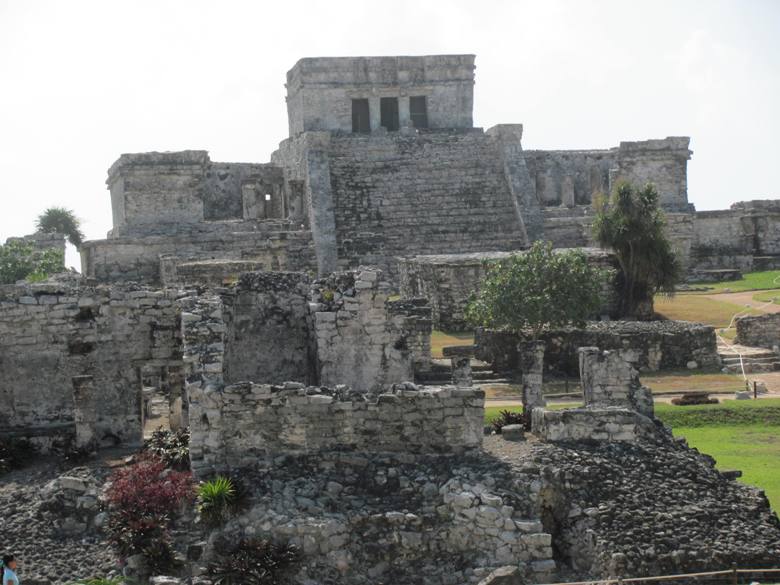Exploring the history of the Mayas

Day 2 — The next time the kids don’t want to do their homework, remind them that knowledge is power.
That’s what the ancient Mayans believed. Those with the most knowledge—the astronomers, the priests, the doctors lived in the closest proximity to the temples, I learn when we visit the spectacular ocean-front ancient Mayan city of Tulum along the Mexican Coast about 75 miles south of Cancun. (www.rivieramaya.com)
One of the best preserved coastal Maya sites — it was at its height between the 13th and 15th Centuries — Tulum is built along the east coast of the Yucatán Peninsula on the Caribbean Sea –the high cliffs protecting the city from hurricanes even in ancient times. Tulum was one of the last cities inhabited and built by the Mayans.
It is a great ruin to visit with the kids because it is relatively small and when you are finished, you can walk down to the beach and cool off.
Our guide Gabriel Morales (it is smart to get a guide at the entrance—less than $50 for four people) explains that perhaps only 800 people—those with the most knowledge—lived within the city while thousands more lived outside.
People who come to this part of Mexico know about the great beaches, the snorkeling and the diving and all of the big, all-inclusive resorts offering tantalizing deals, but what they may not realize at first blush that this is a place where you can have unique experiences like exploring ancient ruins or swimming in an underground Cenote – translated that means sacred water that gives life and these underground river systems crisscross this region. You can even explore a cave.
Yes we did that too at Rio Secreto (http://www.riosecretomexico.com) and it might be one of the most unique experiences I’ve ever had.
Just opened two years ago, it is limited to just 300 visitors a day. Our guide, Alfredo Kuri Ogalde led us as we sloshed through water, squeezed through narrow openings floated, taking care not to touch any of the amazing formations.
What makes this cave so unique is that this is the only cave yet discovered that’s not completely flooded. The formations also are so fantastic — thousands of stalagmites over head — big ones, small ones like a sunburst — because the petrified coral reef overhead is more porous so the formations grow more quickly.
It is 60 degrees underground and the water is just 50 degrees but we’re not cold — maybe out of excitement, maybe because the wet suits and life vests are keeping us warm. We follow our guide past giant calcium dunes.
Warriors had to find their way through the cave before going off to war. The theory was if they confronted the 9 gods of death and survived, maybe they could cheat death again in battle. It is crazy to think we are walking and swimming where Mayans did more than 1000 years ago. We alternately swim, climb and splash through shallow pools of water.
The Mayans also believed that when they died, their souls had to pass through the underworld to be reborn…as we will be when we return to the surface, we’re told.
The colors of the formations are fantastic – orange, sparkling crystal from calcium blue gray, — thousands of stalactites over head — big ones, small ones like a sunburst — because the petrified coral reef overhead is more porous so the formations grow more quickly.
I wouldn’t bring kids younger than six, though, you can’t carry them and they might be scared in the dark place (the lights on our helmets are the only illumination) .
We swim through formations, keeping our heads low, the passage just narrow enough for us to squeeze through. We dive into a pool of crystal clear and freezing water.
It is awesome. We don’t see anyone else in the cave. We walk and we swim and we climb for more than an hour and a half. So far, only about 10 percent of the six or so miles they have explored are used for the tours. Other caves are completely flooded so that only technical cave divers can navigate them.
When we get outside, everything seems brighter. Maybe we have been reborn.
Next: The Sian Ka’an Biosphere Reserve

